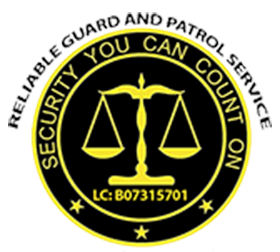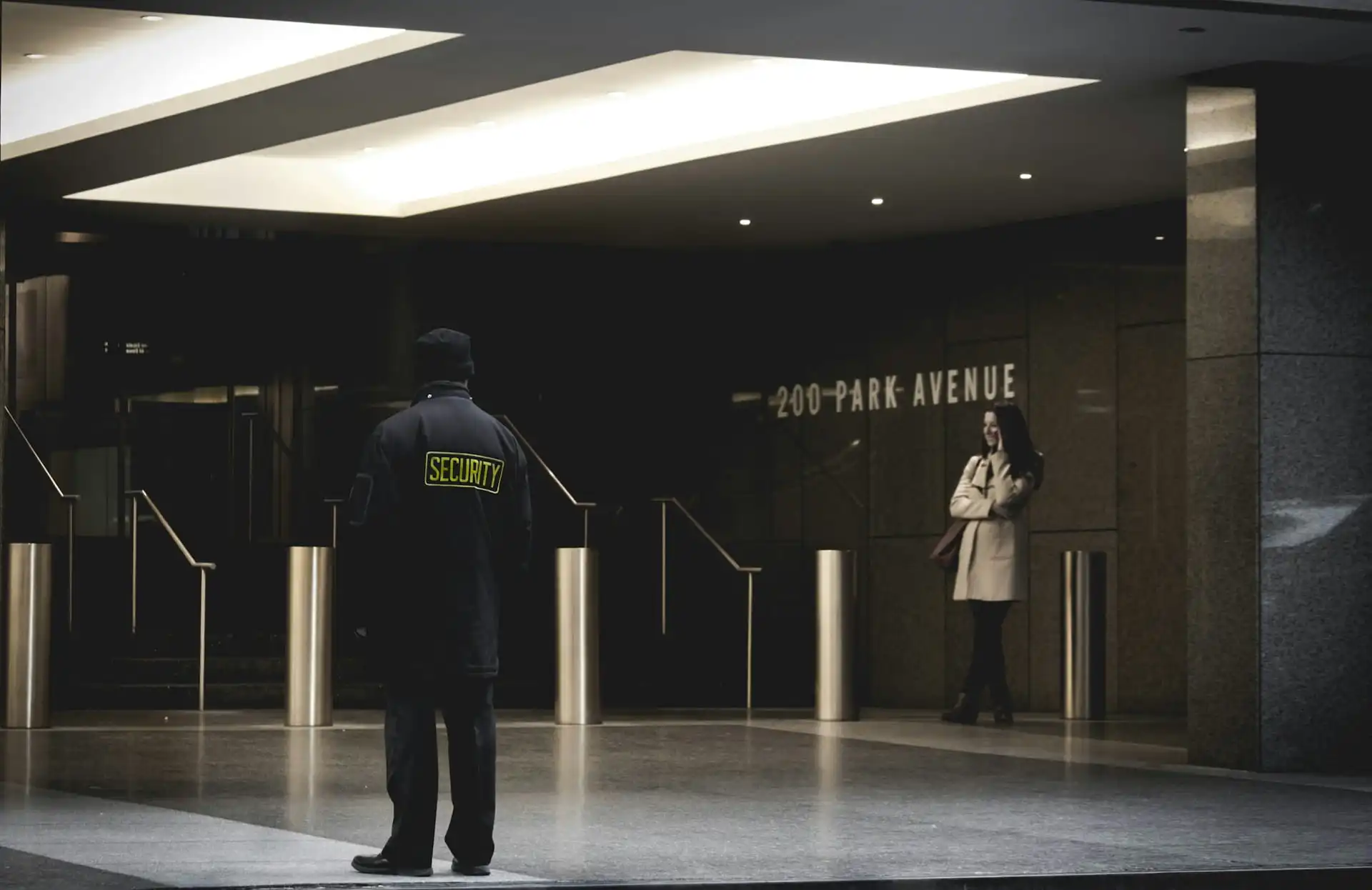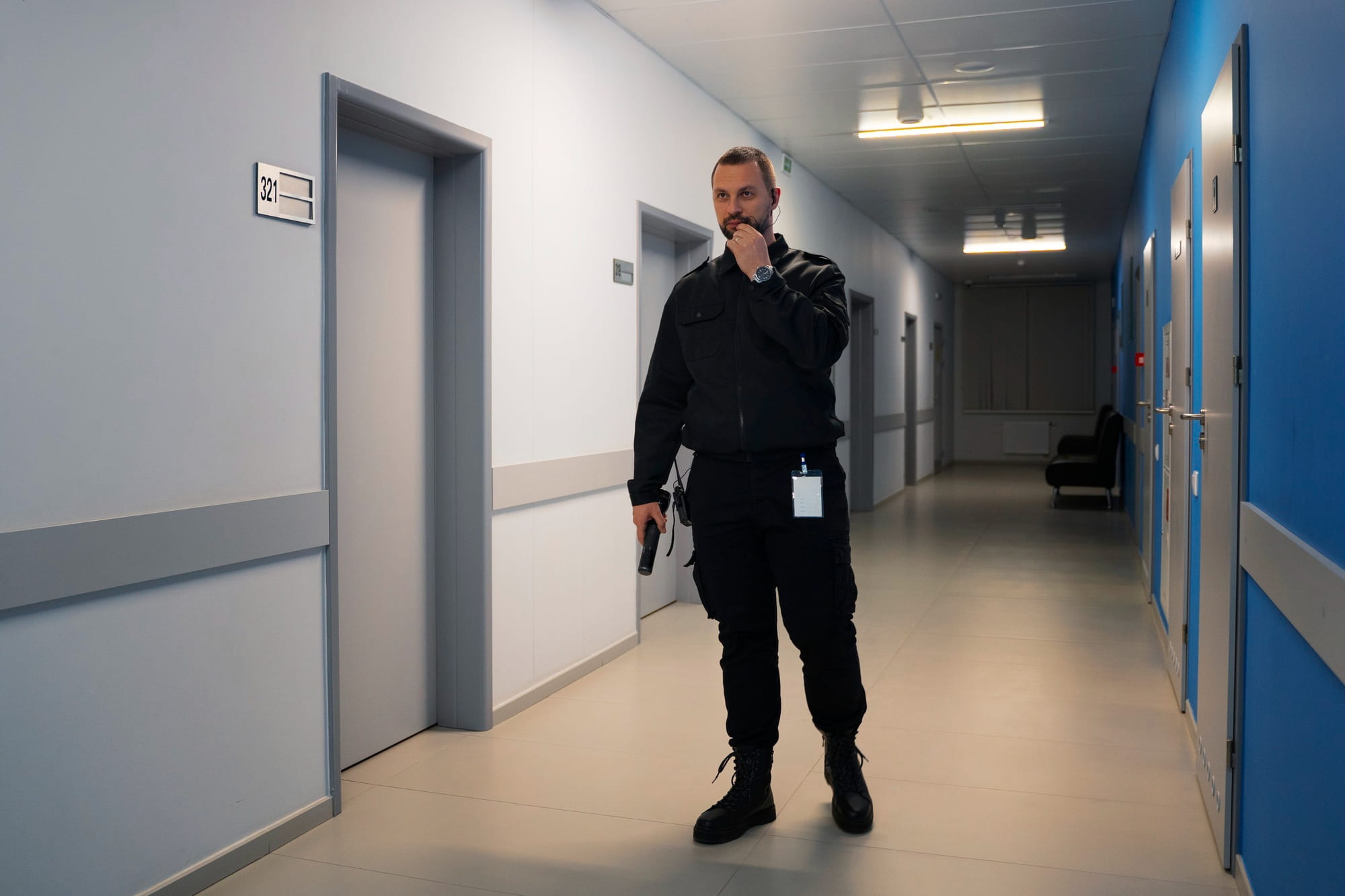
- Sat, Jul 2025
- |
- Reliable Guard and Patrol Service Inc.
Security serves three fundamental purposes: protecting people, safeguarding assets, and preventing unauthorized access to information. In practical terms, security creates defensive layers through physical measures (locks, cameras, guards) and digital safeguards (encryption, firewalls, access controls) that work together to prevent, detect, and respond to threats. For businesses and stores, security guard services in Houston TX prevent theft, protect inventory, and ensure customer safety. For homes, it deters burglars, monitors property, and provides peace of mind. Modern security combines proactive prevention with continuous monitoring and rapid response capabilities to address risks ranging from physical break-ins to cyberattacks. Whether protecting a retail store, corporate office, or residential property, effective security reduces risks, builds trust, and enables normal activities without fear of breaches.

Why Protection Matters in Today’s World
Protection plays a vital role in our increasingly connected society where risks constantly evolve. Personal data and valuable resources require strong defensive measures to prevent unauthorized access and potential losses. Modern life depends heavily on protective systems that guard against both physical and digital threats. Growing technology use creates new weak points that require advanced protective solutions to address effectively. Reliable protective protocols help maintain stability and prevent disruptions in daily activities and business operations. These measures ensure that people can work and live without constant fear of security breaches.
How Protection Methods Changed Over Time
- Protection strategies have transformed dramatically throughout human history to meet changing needs and challenges.
- Early societies relied on physical barriers like walls and human guards for basic defense.
- Ancient communities built fortresses and watchtowers to spot dangers before they reached populated areas.
- Technology brought new protective tools including cameras that monitor areas continuously without human presence.
- Electronic alarm systems replaced traditional watchmen by providing instant alerts when threats appear.
- Digital protection methods emerged as computers became essential parts of daily life and work.
Key Developments in Protection History
- The lock and key invention revolutionized how people secured their belongings and private spaces.
- Professional law enforcement groups formed to provide organized protection for entire communities.
- Digital encryption methods developed to protect information as it travels through computer networks.
- International protection organizations like ASIS International emerged to coordinate efforts across different countries and regions.
- Each advancement built upon previous knowledge to create stronger and more reliable protective systems.
- Modern protection combines physical and digital elements to address multiple threat types simultaneously.

Different Ways to Stay Protected
Protecting Physical Spaces
Physical protection focuses on securing buildings, valuable items, and the people inside them effectively. Modern systems combine multiple layers of defense to create stronger barriers against intruders. Advanced locking systems work alongside monitoring equipment to track movement and detect unusual activities. Trained personnel provide human judgment that technology alone cannot offer in complex situations. Physical barriers like gates and reinforced doors create the first line of defense against threats. These protective measures work together to discourage criminal activities before they happen. Regular maintenance ensures all components function properly when threats emerge unexpectedly.
Digital and Online Protection
Digital protection shields computers and networks from hackers trying to steal or damage information. Various software tools work continuously to block harmful programs and unauthorized access attempts. Protective walls filter incoming data while encryption scrambles sensitive information during transmission across networks. Regular updates strengthen these defenses against newly discovered weaknesses in systems. Security protocols establish rules that users must follow to maintain strong digital defenses. These combined efforts create multiple obstacles that attackers must overcome to breach systems. Organizations invest heavily in digital protection to safeguard their operations and customer data.
Keeping Information Safe
Information protection prevents confidential data from falling into the wrong hands through various methods. Scrambling techniques transform readable data into coded formats that unauthorized users cannot understand. Access restrictions ensure only approved individuals can view or change sensitive information within systems. Backup systems store copies of important data to prevent permanent loss during emergencies. Regular monitoring helps detect unusual access patterns that might indicate security breaches early. These practices work together to maintain data integrity across all storage locations. Proper training ensures everyone understands their role in protecting sensitive information daily.
Individual Safety Measures
Personal protection combines physical awareness with digital habits to reduce individual risk exposure. Learning defensive techniques provides practical skills for handling dangerous situations when they arise. Digital safety practices protect personal information from identity theft and online fraud attempts. Awareness training helps people recognize potential threats before becoming victims of crimes. Emergency planning ensures individuals know how to respond quickly during unexpected dangerous situations. These preparations increase confidence and improve outcomes when facing real threats. Smart devices now offer additional personal safety features through location tracking and emergency alerts.
Protecting Countries and Citizens
National protection involves coordinating multiple agencies to defend against threats from inside and outside borders. Military forces work with intelligence services to identify and neutralize potential dangers early. Law enforcement maintains internal order while border controls monitor who enters and exits territories. These organizations share information to create comprehensive protective networks across regions. Emergency response systems prepare for natural disasters and other large-scale threats to populations. International cooperation strengthens these efforts through shared resources and coordinated planning strategies. Modern technology enhances these protective capabilities through advanced surveillance and communication systems.

Core Rules for Protection
Keeping Information Private
Privacy protection means limiting access to sensitive data only to approved individuals within organizations. Organizations establish strict controls to prevent unauthorized people from viewing confidential materials or records. Data breaches occur when these protective measures fail to block unwanted access attempts. Maintaining privacy helps organizations build strong relationships based on trust with their clients. Legal requirements often mandate specific privacy standards that organizations must follow consistently. Regular audits ensure privacy measures continue working effectively as threats evolve over time. Strong privacy protection supports organizational reputation and prevents costly legal complications from emerging.
Maintaining Data Accuracy
Data accuracy focuses on keeping information correct and unchanged without proper authorization from designated personnel. Protective systems monitor all changes to ensure only approved modifications take place within databases. Unauthorized alterations can damage trust and create serious problems for decision-making processes. Regular verification procedures help detect any unwanted changes to important records or files. Information loses value when people cannot trust its accuracy or completeness anymore. System controls prevent both accidental and intentional tampering with critical data elements. These safeguards work continuously to preserve information quality throughout its entire lifecycle.
Ensuring System Access
System access means authorized people can reach needed information whenever their work requires it. Technical teams work around the clock to keep systems running without unexpected interruptions. Backup systems activate automatically when primary systems experience problems or require maintenance work. Infrastructure protection prevents both physical damage and digital attacks from disrupting normal operations. Quick response procedures minimize downtime when issues do arise despite preventive measures. Regular testing ensures backup systems will function properly during actual emergency situations. These efforts combine to maintain consistent service delivery for all authorized system users.
Tracking User Actions
Action tracking creates detailed records showing who did what within protected systems and when. These records help identify problems quickly and determine exactly how security incidents occurred. Monitoring systems observe user activities without interfering with legitimate work tasks or productivity. Clear documentation supports investigations when suspicious activities require further examination by security teams. Regular reviews of activity logs reveal patterns that might indicate emerging security risks. Corrective actions become possible only when organizations understand exactly what went wrong previously. This systematic approach ensures everyone remains responsible for their actions within protected environments.

Physical Security
Building Blocks of Physical Protection
Physical protection combines several defensive layers that work together to shield people and valuable resources. Environmental design shapes spaces to naturally discourage unwanted visitors from entering restricted areas. Access control systems manage who can enter specific locations at different times throughout facilities. Monitoring equipment watches over areas continuously to spot unusual activities before problems develop. Response plans outline exactly how teams should react when security incidents occur unexpectedly. These interconnected elements create stronger defense than any single measure could provide alone. Each layer supports the others to form comprehensive protection against various physical threats.
Why Physical Protection Matters
Physical safeguards protect real-world assets including buildings, equipment, and the people working inside them daily. These measures serve as the initial barrier preventing unauthorized individuals from causing harm or damage. Strong physical defenses stop theft attempts and protect valuable resources from being compromised. Safety protocols ensure operations continue smoothly without disruptions from security incidents or breaches. Well-planned protection systems give employees confidence to focus on their work productively. Regular assessments help identify weak points before criminals can exploit them successfully. Organizations depend on these measures to maintain stable environments for conducting business effectively.
Common Physical Protection Methods
- Various protective tools and strategies help secure facilities against unauthorized entry and potential threats:
- Fencing creates visible boundaries that clearly mark restricted areas around buildings or properties
- Locking mechanisms control entry points while providing different security levels for various areas
- Entry management systems track movement and verify identities before granting access to spaces
- Trained personnel from professional security services patrol areas and respond quickly when automated systems detect potential problems
- Camera networks record activities continuously while providing real-time monitoring capabilities for security teams
- Lighting systems illuminate dark areas to eliminate hiding spots and improve camera effectiveness
- Alarm systems alert response teams immediately when unauthorized access attempts occur anywhere
These combined measures form multiple defensive layers that adapt to different threat levels accordingly. Strategic placement ensures complete coverage without creating operational bottlenecks for authorized personnel.

Information Security
Why Data Protection Matters
Data protection plays a vital role in safeguarding against security breaches and identity theft incidents. Organizations face serious financial losses and damaged reputations when sensitive data gets compromised. Strong security measures help maintain the privacy and accuracy of personal and business information. These practices create confidence among users and strengthen overall digital safety standards as outlined by Infosecurity Magazine. Proper data protection also helps organizations maintain smooth operations without disruption from security incidents.
How to Secure Your Data
Organizations use various methods like encryption and access management to protect valuable information assets. Regular security reviews help identify weaknesses before problems occur in any system. Creating clear security guidelines gives everyone a framework for handling sensitive data properly. These protective steps reduce the chances of unauthorized people accessing confidential information. Following established security protocols helps meet legal requirements while defending against online threats.

What Personal Safety Means and Why It Matters
Personal safety involves taking active steps to protect yourself from various dangers in everyday life. These dangers include physical attacks, theft, online threats, and other risks around you. Taking safety precautions helps ensure your physical wellbeing and provides mental comfort throughout daily activities. People who practice good personal safety habits feel more confident and secure wherever they go. Your overall quality of life improves when you know how to protect yourself effectively.
Ways to Protect Yourself Every Day
Smart personal safety practices include several practical steps anyone can implement immediately. Important security measures include:
- Using mobile safety applications that track your location during travel or emergencies
- Sharing your schedule and destination details with family members or trusted friends regularly
- Staying alert to your surroundings and avoiding potentially dangerous situations whenever possible
- Learning basic self-defense techniques that could help during threatening encounters
- Keeping emergency contacts easily accessible on your phone or in your wallet
Preparation and awareness significantly lower your chances of becoming a victim of crime. Quick thinking and proper planning help you react appropriately when facing unexpected dangers.

National Security
National security keeps countries stable and protects their independence and citizens’ way of living. Government departments must work together to handle both traditional and new types of threats. International partnerships help nations address dangers in our connected and complicated world effectively. Countries need strong security systems to maintain their freedom and protect their borders properly. A secure nation can better serve its people and participate in global affairs confidently.
Dangers That Countries Face
Modern security threats go far beyond traditional military conflicts between nations. Major risks include:
- Cyber attacks that damage important systems like power grids and communication networks
- Spy activities that steal classified government information and military secrets
- Economic warfare that disrupts financial systems and trade relationships between countries
- Terrorism that creates fear and instability within civilian populations
- Natural disasters that overwhelm response capabilities and damage critical infrastructure
These threats can weaken economies and reduce citizens’ confidence in their government’s abilities. Nations struggle to operate normally when facing multiple security challenges at once.
How Countries Protect Themselves
Effective security requires multiple approaches working together to shield nations from various risks. Key protection methods include:
- Building community readiness programs that prepare citizens for emergency situations
- Creating strong diplomatic ties with other nations to prevent conflicts peacefully
- Identifying and fixing internal weaknesses before enemies can exploit them
- Developing advanced defense systems that adapt to changing threat patterns
- Training specialized teams to respond quickly when security incidents occur
Comprehensive planning protects a country’s independence, economic stability, and population from changing dangers. Security strategies must evolve constantly to match new threats emerging worldwide.

Understanding Security Risk Management
Security risk management means finding, evaluating, and reducing threats that could harm people, property, or business operations. Organizations use this process to spot weaknesses before problems occur and protect their resources effectively. Taking action early prevents security incidents and reduces damage when threats do appear. Strong risk management systems help businesses maintain smooth operations even during challenging situations. Companies that manage risks well build stronger defenses against various security challenges over time. Regular risk reviews keep protection measures current and effective against new threats.
How to Assess Security Risks
Risk assessment starts with identifying all possible threats that could affect your organization’s assets and operations. Security teams evaluate how likely each threat is and what damage it might cause. After understanding these risks, organizations create specific protection measures to reduce or remove each danger. Regular assessments catch new vulnerabilities as technology and threats continue to evolve quickly. Teams must document their findings carefully to track improvements and identify patterns over time.
Methods to Reduce Security Threats
Organizations use multiple approaches to lower their security risks and protect valuable resources. Effective reduction methods include:
- Installing security technology like firewalls, cameras, and monitoring systems throughout facilities
- Setting up strict access controls that limit who can enter sensitive areas
- Performing regular security checks to find and fix weak points quickly
- Creating detailed response plans that guide teams during security incidents
- raining staff members to recognize and report suspicious activities immediately
These combined efforts create multiple layers of protection against different types of threats. Quick response capabilities minimize damage when security breaches do occur despite preventive measures.
Why the Security Industry Exists
The security industry protects individuals, buildings, and data from various dangers to ensure public safety. Security services discourage criminal activity, watch for suspicious behavior, and react quickly during emergencies. Professional security teams work in homes, businesses, and government facilities to maintain safety standards everywhere. The industry adapts constantly as new threats emerge in both physical and digital environments. Security professionals provide peace of mind by creating safer spaces for everyone.
Main Roles of Security Services
Crime Prevention: Security staff create visible deterrents that stop criminals from attempting theft or property damage. Their presence alone often prevents many incidents from happening in protected areas. Armed security guard services provide enhanced protection for high-risk locations.
Risk Assessment: Security experts examine properties thoroughly to find weak spots and suggest protective improvements. These evaluations help clients understand their vulnerabilities and strengthen their defenses appropriately. Industry standards from the Security Industry Association guide these assessments.
Emergency Response: Fast action during fires, break-ins, or medical situations saves lives and reduces property damage. Security teams coordinate with emergency services to ensure help arrives quickly.
Monitoring Services: Advanced cameras, alarms, and tracking systems watch for unusual activities around the clock. Real-time monitoring allows immediate responses to potential security threats before they escalate. Shopping center security in Houston TX uses these technologies extensively.
Cybersecurity: Digital protection services guard computer systems and data from online attacks and breaches. Security experts use encryption, firewalls, and other tools to keep information safe.
Access Control: Managing entry points ensures only authorized people reach restricted areas containing valuable items. Proper access systems protect sensitive information and expensive equipment from unauthorized users. Hotel security guards service in Houston TX specializes in managing guest and staff access.
Security services aim to build safe environments where people work and live without constant worry. Protected spaces allow normal activities to continue smoothly without disruption from security concerns.
Conclusion
Security remains an essential foundation for modern society, where digital and physical threats continuously evolve alongside technological advancement. The combination of individual awareness and organizational commitment creates multiple defensive layers that protect what matters most. Reliable information from authoritative sources empowers people to make informed decisions about their protective strategies. As threats become more sophisticated, the need for comprehensive protection grows stronger across all sectors.
Communities thrive when citizens actively participate in collective safety efforts while maintaining their personal defenses. Educational resources bridge the gap between complex security concepts and practical everyday applications for everyone. Moving forward, success depends on staying informed, implementing proven protective measures, and adapting strategies as new challenges emerge in our interconnected world. Organizations like Reliable Guard and Patrol Service Inc, continue advancing protection standards to meet evolving community needs.
Frequently Asked Questions
What does protection aim to achieve?
Protection works to shield valuable resources, information, and people from unwanted intrusions and potential dangers. Its primary goal involves creating barriers that prevent harmful incidents before they can cause damage. Continuous monitoring helps identify threats early and enables quick responses to emerging risks. Warehouse security guard service Houston TX exemplifies this approach in protecting commercial facilities.
Why does everyone need protective measures?
Protective measures preserve confidentiality while defending against digital attacks and maintaining confidence in various systems. People depend on these safeguards for their personal well-being and financial security every day. Organizations require protection to maintain operations and serve their communities without interruption. The Occupational Safety and Health Administration provides guidelines ensuring workplace safety standards.
How do protective strategies help organizations?
Well-designed protective strategies reduce potential dangers while strengthening an organization’s ability to handle unexpected challenges effectively. These measures build confidence among customers who trust organizations with their sensitive information and resources. Strategic planning ensures business activities continue smoothly even when facing various security challenges. Construction site security Houston demonstrates specialized protection for high-risk environments.
What protective tools do people commonly use?
Popular protective tools include data scrambling techniques, entry restrictions, defensive barriers, and routine system examinations for vulnerabilities. These methods work together to stop threats while identifying suspicious activities across different platforms. Regular updates keep these tools effective against newly discovered risks and attack methods. Professional Security magazine provides insights into the latest security technologies.
Who gains advantages from stronger protection?
All members of society benefit when protective measures secure personal information, monetary resources, and essential services effectively. Individual citizens enjoy safer online experiences while organizations operate with reduced risk of disruptions. Government services maintain stability through comprehensive protective frameworks that serve entire populations reliably. Event security services Houston shows how specialized protection benefits large gatherings.
How can individuals strengthen their personal defenses?
Creating complex passwords and keeping software current provides basic protection against common digital threats individuals face. Learning to recognize deceptive messages helps avoid falling victim to online fraud attempts. Careful behavior when sharing information online reduces exposure to various risks significantly. Resources from Security Today offer practical tips for personal protection. For professional consultation, visit our contact page or learn more about us. We also provide unarmed security guard Houston TX services and coverage in Sugar Land TX and Pearland TX. The Houston Partnership supports local security initiatives, while organizations can earn the Certified Protection Professional designation and follow standards from the Private Security Professionals of America. Stay updated with industry news through Security Magazine.



